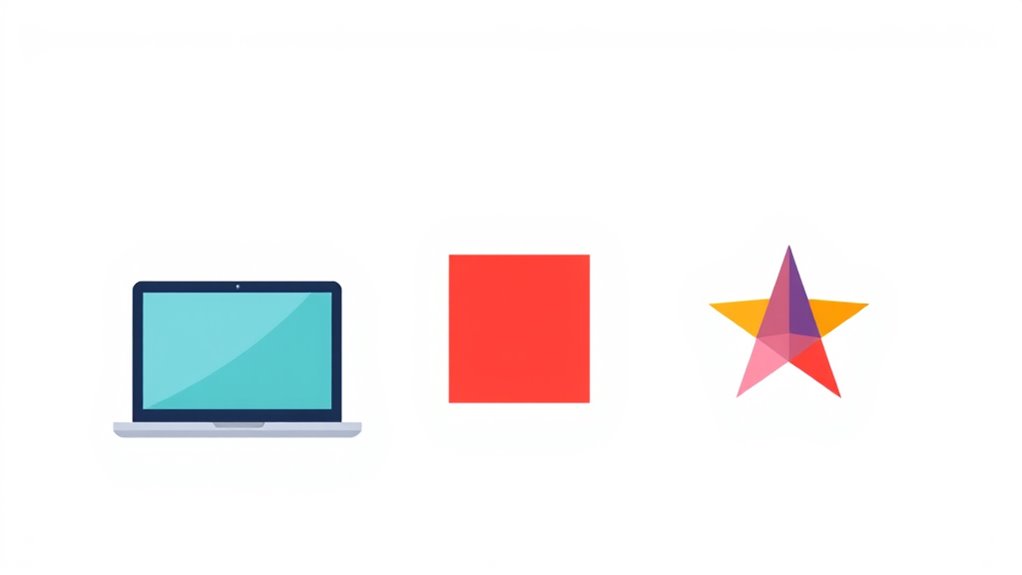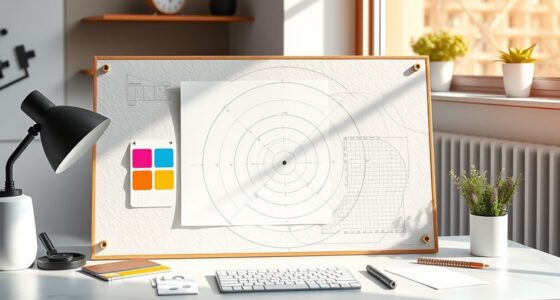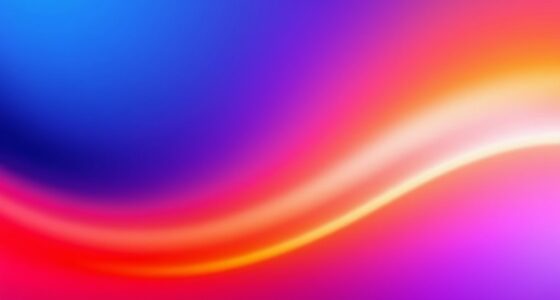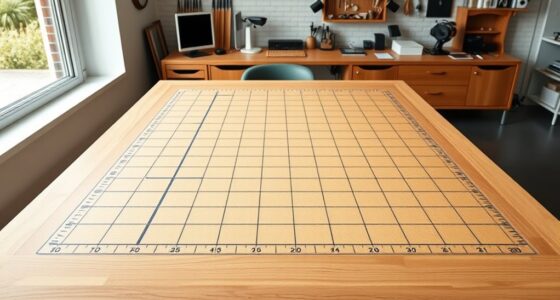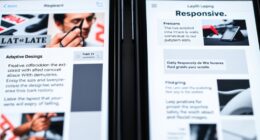Flat design is a modern style that focuses on simplicity, clean lines, bright colors, and minimal elements, making interfaces easy to understand and fast to load. It avoids shadows, textures, and 3D effects, emphasizing usability and clarity. You should consider it for sleek websites, mobile apps, or projects needing quick performance and a professional look. Keep exploring to discover how to apply flat design effectively to enhance your user experience.
Key Takeaways
- Flat design emphasizes minimalism with simple shapes, bold colors, and clear typography, avoiding shadows and textures.
- It originated in the early 2000s to improve responsiveness and speed, especially on mobile devices.
- Ideal for modern websites, mobile apps, e-commerce, and brands seeking a clean, professional, and user-friendly interface.
- It reduces visual clutter, enhances load times, and ensures consistency across platforms.
- Use flat design when prioritizing simplicity, fast performance, clarity, and a contemporary aesthetic.
Defining Flat Design: Key Characteristics and Features
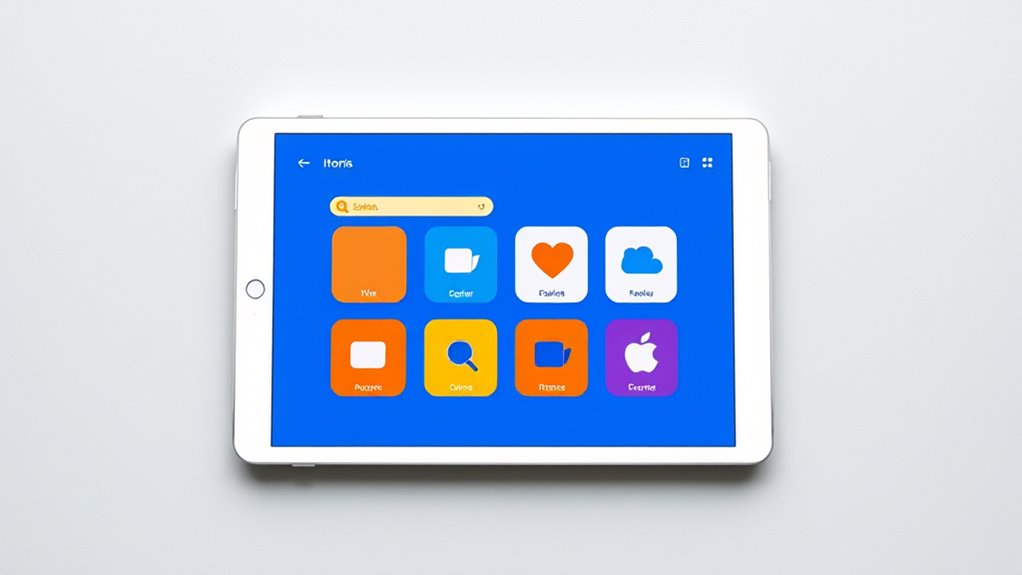
Flat design is a minimalist approach that emphasizes simplicity and clarity by removing three-dimensional effects. You’ll notice flat design uses clean lines, simple shapes, and bold colors to create a straightforward visual style. It avoids gradients, shadows, and textures that give objects a sense of depth, focusing instead on flat, two-dimensional elements. Typography plays a key role, often featuring large, clear fonts that enhance readability. Icons are simple, with minimal detail, making them easy to recognize and understand. Overall, flat design aims to streamline user experience by reducing clutter and emphasizing essential information. Its emphasis on minimalism makes interfaces more modern, fast-loading, and adaptable across different devices and screen sizes. Additionally, it aligns with design principles like contrast and hierarchy, promoting better visual communication. By focusing on user-centered design, flat design helps create more intuitive and engaging interfaces that meet modern user expectations. Furthermore, the use of minimalist visuals reduces cognitive load, making interfaces easier and more enjoyable to navigate. The trend is increasingly supported by advancements in technology compatibility, ensuring seamless performance on various platforms. This approach also encourages a focus on content over decoration, which is fundamental in embracing minimalism and creating clean, effective designs.
The Evolution and Origins of Flat Design
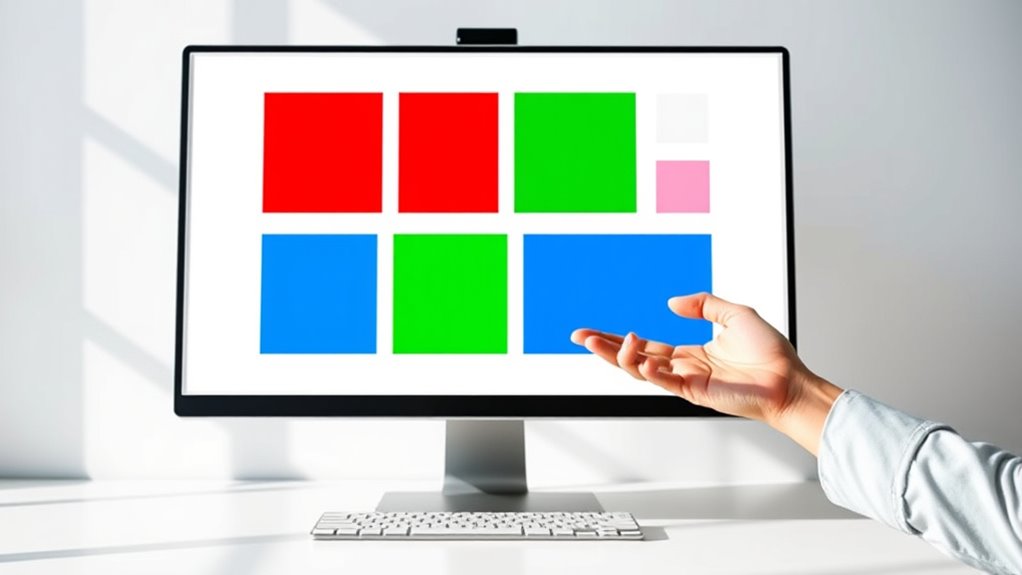
The origins of flat design can be traced back to the early 2000s, as designers sought ways to create cleaner, more efficient interfaces amid increasing digital complexity. During this time, they moved away from skeuomorphism’s detailed textures and shadows, favoring simplicity. This shift was driven by the desire for faster loading times, better responsiveness, and a more modern look. As technology evolved, flat design gained momentum with major platforms like Microsoft’s Metro design and Apple’s flat UI updates. You can feel the excitement of this movement by recognizing how it:
- Embraced minimalism for clarity and usability.
- Responded to the rise of mobile devices with adaptable visuals.
- Sparked a design revolution that emphasizes function over ornamentation.
- Its popularity surged as it aligned well with the digital design trends emphasizing efficiency and user experience.
Benefits of Implementing Flat Design in Your Projects
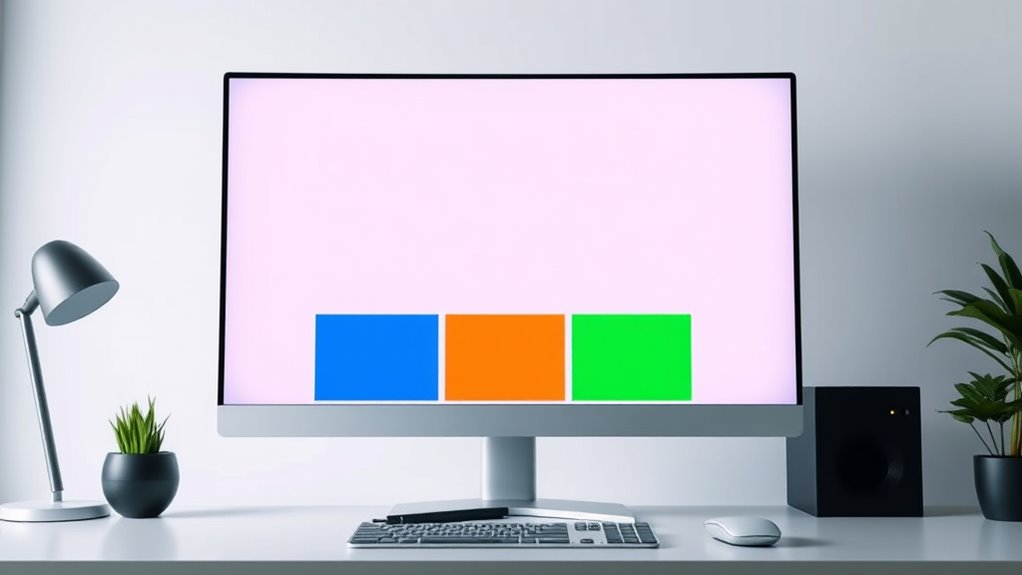
Implementing flat design in your projects offers numerous advantages that can enhance both user experience and development efficiency. Its clean, minimal aesthetic reduces visual clutter, making interfaces easier to navigate and understand. This simplicity speeds up loading times, especially on mobile devices, improving overall performance. Flat design also promotes consistency across different screens and platforms, which helps users develop familiarity and trust with your app or site. Additionally, because it relies on basic shapes, colors, and typography, it’s easier and faster to create, update, and maintain. This streamlined approach reduces development costs and minimizes the need for complex graphics or animations. Furthermore, design standards in flat design ensure a cohesive look and feel across your digital products. The widespread adoption of flat design has been driven by its popularity among designers and developers seeking modern, efficient solutions. Overall, adopting flat design can lead to a more modern, user-friendly product that performs well and is easier to manage over time.
Common Use Cases and Ideal Scenarios for Flat Design
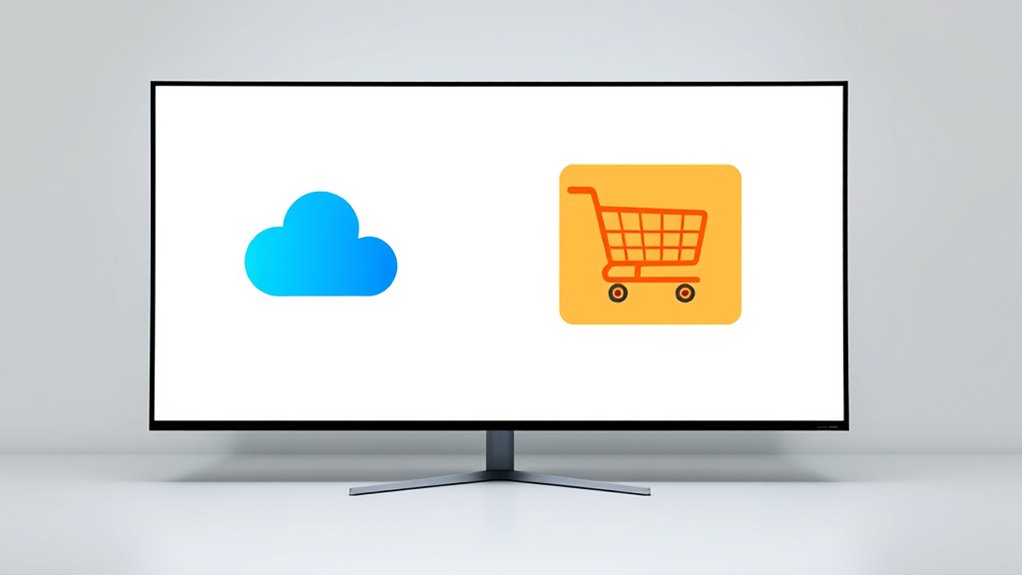
Are you wondering when flat design is most effective? Flat design works best in scenarios where clarity, speed, and modern aesthetics matter most. Here are three ideal use cases:
Flat design excels when clarity, speed, and modern aesthetics are essential for your digital projects.
- Mobile Apps – Flat design offers a clean, intuitive interface that enhances user experience on smaller screens. It also helps improve loading times, which is crucial for mobile performance. Additionally, its simplicity supports responsive design, ensuring a consistent look across devices. Its minimalistic approach also reduces visual clutter, making it easier for users to focus on key actions.
- E-commerce Websites – Its simplicity helps highlight products, making browsing quick and engaging.
- Startups and Tech Brands – The modern look communicates innovation and freshness, appealing to a tech-savvy audience.
- It also supports emotional support by creating visuals that are straightforward and calming, reducing cognitive overload for users.
This style keeps users focused, reduces load times, and creates a sleek, professional appearance. When you want your digital presence to feel current and user-friendly, flat design is a powerful choice. It’s perfect for projects aiming for minimalism without sacrificing impact.
Comparing Flat Design With Other Design Styles
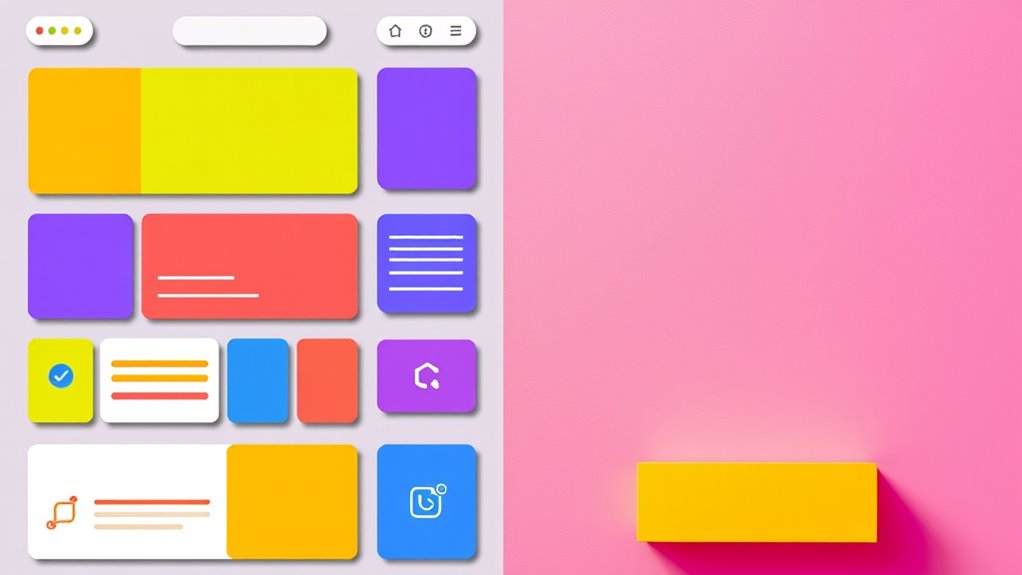
While flat design excels in creating sleek, straightforward interfaces, it’s just one of many styles designers can choose from. For example, skeuomorphic design mimics real-world textures and objects, offering visual cues that make apps intuitive. Material Design combines flat elements with subtle shadows and depth, giving interfaces a layered feel. Skeuomorphism often feels more tactile, while flat design emphasizes minimalism and clarity. Meanwhile, neumorphism merges flat design with soft shadows for a modern, tactile look. Your choice depends on your goals: flat design promotes simplicity and speed, while other styles can add realism or depth to enhance user engagement. Additionally, design versatility such as accommodating different user preferences and device capabilities should influence your design choice. Understanding these differences helps you select the most effective style for your project’s purpose and audience, especially when considering user experience considerations, which can be impacted by cybersecurity factors like security features and user safety. Incorporating visual hierarchy effectively ensures that key information stands out, regardless of the chosen style.
Tips for Effectively Applying Flat Design Principles
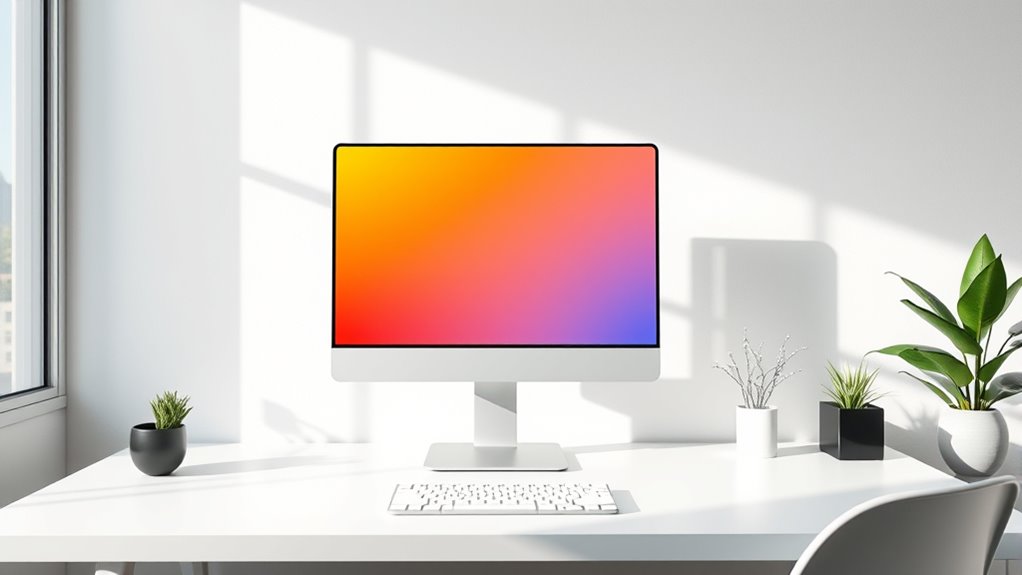
To apply flat design principles effectively, focus on simplicity and clarity in every element you create. Keep your interface free of unnecessary details, using bold colors and clean lines to guide users effortlessly. Prioritize user experience by ensuring each component serves a clear purpose. Here are three tips to help you succeed:
- Use vibrant, contrasting colors to evoke emotion and draw attention to key features.
- Limit the number of fonts and sizes to maintain consistency and reduce visual clutter.
- Incorporate ample whitespace to improve readability and create a sense of calm.
Frequently Asked Questions
How Does Flat Design Impact Website Accessibility?
Flat design can improve website accessibility by simplifying visuals and reducing clutter, making it easier for users to focus. You benefit from clear, high-contrast colors and straightforward navigation, which aid those with visual impairments or cognitive challenges. However, if not implemented carefully, flat design might lack sufficient contrast or tactile cues, so you should confirm accessibility standards are met, like proper color contrast and text readability.
What Are Common Mistakes to Avoid With Flat Design?
Think of flat design as a clear, uncluttered garden—beautiful but easy to navigate. Avoid common mistakes like over-simplifying to the point of losing functionality, neglecting contrast, or ignoring user needs. Don’t clutter your space with unnecessary elements or tiny icons that frustrate users. Instead, focus on simplicity that guides users effortlessly. Keep your design balanced, accessible, and user-friendly, ensuring your garden remains inviting and functional for everyone.
Can Flat Design Be Used Effectively in Branding?
You can definitely use flat design effectively in branding, especially if you want a modern, clean look that’s easy to recognize. It helps your brand appear sleek and contemporary, making your message clear without unnecessary clutter. Just make certain your logo and visual elements stand out with bold colors and simple shapes. When used consistently, flat design can strengthen brand identity and improve user experience across all platforms.
How Does Flat Design Influence User Engagement?
Imagine visiting a sleek app with bold icons and minimal clutter—flat design makes this possible. It influences your engagement by making interfaces easier to navigate, reducing cognitive load, and creating a modern, appealing look. For example, a fitness app that uses flat design saw users spend 20% more time exploring features. This style keeps you focused, improves usability, and encourages continuous interaction.
Is Flat Design Suitable for All Types of Digital Products?
You might wonder if flat design fits all digital products. While it works well for apps and websites focusing on simplicity and quick navigation, it’s not ideal for complex interfaces requiring detailed visuals or rich textures. Flat design emphasizes minimalism, so if your project benefits from a modern, clean look without heavy graphics, it’s a great choice. However, for highly immersive or detailed experiences, consider other design styles.
Conclusion
Embracing flat design can truly elevate your projects, making them sleek and user-friendly. Some might worry it feels too simple or lacks depth, but with thoughtful use, flat design creates clarity and modern appeal that attracts users. Don’t let fear hold you back—by choosing flat design, you’re crafting intuitive experiences that resonate and inspire confidence. Jump in, experiment, and watch your work stand out with clean, impactful visuals.
